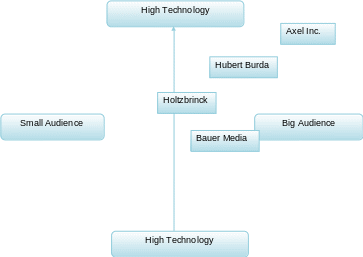Introduction
Business organizations thrive in the challenging markets using different business strategies. The environment in which a business operates often contributes to the strategies that a business organization adopts. This analysis is a case of the Axel Springer, a longtime German multimedia corporation that used various strategies and operational techniques to survive moments of high dilemmas entailing corporate responsibility. Using the case of the Axel Springer, this essay analyses the issues of corporate directional strategy, generic business strategy, and elements of functional strategy, while also providing recommendations on its business environment. The paper will use two business models: the Abella business framework and the VRIO model.
Description of the Business Nature of the Axel Springer
Abella’s business framework for corporate development and corporate management identifies a business through its corporate directional strategy, its generic business strategy, and its functional strategy. A directional strategy is a form of an investment strategy where a company designs strategies for net short or net long market position plans. Based on the historical development and continued progress of the Axel Company, the directional business strategy for Axel seems to be the market neutral strategies that involve balancing present business situations with certain business changes, since it balanced paper-based media with digital media.
The Porter’s generic strategies contain four major dimensions that a business organization can incorporate to ensure a continued survival in a challenging environment. In terms of its generic business strategy, Axel utilized the differentiation strategic plan that involved creating various digital media communication systems that boosted easy access to news and easy access to knowledge sharing digital utilities. Functional strategy involves selecting specific decision rules that suit specific functional area of an operating business. For the Axel Company, the dominant functional strategies of the firm depended on financial stability, proper marketing of its digital migration plans, and proper scheming of the management.
SWOT and the Competitive Strategy
To understand the success of the Axel Springer, it is important to consider an assessment of its business environment using the SWOT business model, which entails an analysis of the Strengths, Weaknesses, Opportunities, and Threats of the firm. The Strengths- the notable strengths that contributed to the survival of the Springer Company in Europe include its longtime market reputation, its effective marketing techniques of the paper and digital media, and its powerful management system that effected innovative business strategies. A positive reputation made enhanced trust among its consumers, who willingly shifted from the paper-based media to the digital media due to the established trust and reputation.
In terms of Weaknesses, the company internally lacked frameworks that could support the effective reduction, reusing, and recycling of the hotly contested paper material. Additionally, the company lacked policies that would control the spread of digital content within the company, even as the issue of digital content theft prevailed. Such internal weaknesses made the organization susceptible to external pressures that targeted them primarily on issues of corporate responsibility. In terms of the prevailing opportunities, the digital media platform offered varied opportunities where corporate irresponsibility deems uneasy to expose. Moreover, the German consumers and other European consumers remained enthusiastic about their digital migration.
For the threats that presented themselves in the market, Axel Springer was surviving in a hotly debated business paradigm. Concerning the prevailing threats, Axel Springer Company could not influence the operations of the mobile phone producers, could not afford an alternative material suitable for the paper media, and could not influence the anti deforestation campaigns that directly affected their market survival. Additionally, since social responsibility of the digital content primarily rested upon the authors, the threat that Axel Company still had to counter was the growing concern about the unethical content spread over their platforms.
Competitive Analysis, Strategic Groups, & the Perceptual Map
Apart from the quandaries associated with digital media, Axel Springer was facing some imminent competition from other digital publishing firms. Among the leading competitors in the digital media and communication realm, include the Hurbert Burda Media Company, the Bauer Media Group, the Bertelsmann Newspaper Publication Company, and the Holtzbrinck Newspaper Company. These major competitors are constantly providing business challenges to the Axel Company in terms of the modern newspaper business and in the development and distribution of the digital content. The diagram below is a perceptional framework concerning the above competitive analysis.

Conclusion
Keeping track of the rising changes and setting up the required strategies to adopt changes in a business environment is what enabled the Axel Springer to maintain its competitive advantage for several years. Despite the growing challenges of ensuring that the company observes the fundamentals of corporate responsibility, the company has marveled through ensuring that each arising issue receives an effective plan. To recommend, Axel Springer ought to air the issues of Congo environmental and ethics problems in a bid to safeguard nature and ensure that other partners in the mobile technology, who contribute to their success, uphold corporate responsibility.